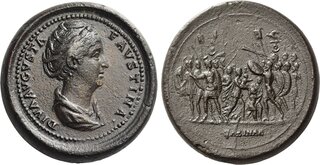| Numismatica Ars Classica > Auction 146 | Auction date: 8 May 2024 |
| Lot number: 2346 Price realized: This lot is for sale in an upcoming auction - Bid on this lot  | Show similar lots on CoinArchives Find similar lots in upcoming auctions on |
| Lot description: Faustina I, wife of Antoninus Pius. Diva Faustina. Medallion after 141, Æ 42 mm, 86.81 g. DIVA AVGVSTA – FAVSTINA Draped bust r., hair waved and coiled at top of head. Rev. Fight between Romans and Sabine: at sides, two groups of soldiers , while in the middle, women and children trying to separate them; in exergue, SABINAE. Cf. C 60 = Gnecchi –,2 and pl. 56, 6 (these reverse die, legend misdescribed due to the poor condition) An apparently unique obverse variety of a type of the highest rarity. An impressive medallion with a spectacular and interesting reverse composition struck on a very heavy and large flan. Brown tone and good very fine This remarkable medallion struck under Antoninus Pius celebrates two important events in his reign, the lavish funeral given for his wife, the Augusta Faustina the Elder, in November 140, and the 900th anniversary of the foundation of Rome, which was celebrated on 21 August 148. The obverse features the portrait of the dead empress and indicates her apotheosis as a new goddess by the surrounding legend naming her as Diva Faustina. The dramatic scene on the reverse however, refers to an important event in the early legendary history of Rome-the abduction of the Sabine women. After the foundation of Rome, Romulus and his male followers realised that the city would have no future without a population that could grow and continue through later generations. In order to solve this serious problem, they needed wives with whom they could have children. Unfortunately, the neighbouring Latin peoples, especially the Sabines, feared the potential power of Rome and refused to permit their daughters to marry Roman men. Romulus therefore took matters into his own hands and devised a scheme to ensure the continuation of the Romans. He held a great festival at Rome in honour of Neptune Equester and invited the neighbouring peoples to attend. Once the throngs of Latins had arrived to take in the spectacle, Romulus gave a signal at which many of the Roman men burst forth and abducted women to take as their wives. Although, not surprisingly, the women who were carried off were indignant at this treatment, Romulus implored them to accept their new husbands and they did. The Latin peoples who had been wronged by Romulus sought revenge and the return of their daughters by making war on Rome. Although the Romans successfully defeated the attacks made by the Caeninenses, Antemnates, and Crustumini and conquered their cities, the Sabines under the leadership of their king, Titus Tatius, were much more dangerous. Secretly let into Rome through the betrayal of Tarpeia, the Sabines faced the Romans in the famous Battle of Lacus Curtius. The Roman line was broken and the Sabines seemed poised for victory when Romulus rallied his forces and resumed the fight. At this point, the abducted women, many of whom by now had children by their Roman husbands, interposed themselves between the warring parties and begged them to end the fighting for their sake, since they desired neither to become widows nor to bear guilt for the deaths of their parents. This very moment, which is depicted on the medallion, softened the hearts of the Sabines and Romans, and they agreed to become one people living in Rome. Titus Tatius subsequently ruled jointly with Romulus until his death five years later. This medallic type was important not only in the immediate context of the anniversary celebrations overseen by Antoninus Pius, but also in the development of Roman medallions. It was frequently copied in the Late Antique period as a reverse type for contorniate medallions, apparently due to its representation of a glorious pagan Roman past in the face of the growing power of Christianity. Estimate: 10000 CHF |  |



